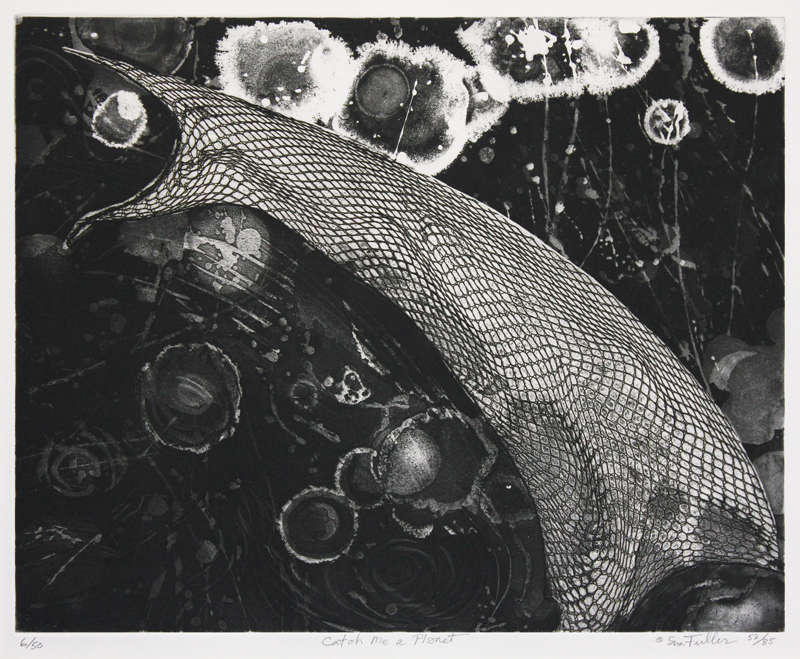Catch Me a Planet is a combination of softground etching and aquatint created in 1952 by American artist Sue Fuller. The plate was created in 1952 but not editioned until 1985. This intaglio is pencil signed, titled, editioned 6/50, and dated. It was printed by the artist on a heavy wove paper and the platemark measures 10-7/8 x 13-5/8 inches.
Catch Me a Planet reflects Fuller’s interest in scientific study and advancement. It was created three years before the space competition began between Russia and the United States in 1955 and five years before the launch of Sputnik 1. In a May 1978 letter to Florence Forst, Fuller explained: “I have always admired what engineers do – the space age is my meat – and not monsters and glop of science fiction – but the real inquiries which succeed – in expanding the mind of a parochial-inclined humanity. Limitations delimited – that’s what I like. They always said it couldn’t be done – so do it and open up world upon worlds of new knowledge from which to search out better ways and meaning to the human experience. … My business is to know what I believe, do what I see, and listen to what is really important – those observations (usually scientific) which portend great things for mankind – and to be done with the dust of ages.”
Sue Fuller, painter, printmaker, sculptor and teacher, was born in Pittsburgh, Pennsylvania in 11 August 1914. Her formal training began at the Carnegie Institute of Technology, where she studied under Joe Johns. During the summer of 1934 she enrolled in a summer course with Hans Hoffman. She graduated from Carnegie with her BA in 1936, and then received her MA in 1939 from Columbia University Teachers College.
Fuller first worked at Stanley William Hayter's Atelier 17 in 1943 after having already established a career as a printmaker and three-dimensional artist. She excelled in new approaches to the plate, finding inspiration in the ability to manipulate the surface of something that appears otherwise immovable. Fuller continued to experiment with a variety of mediums, including glassmaking and calligraphy.
Fuller received a Tiffany Fellowship, a Guggenheim Fellowship, a National Institute of Arts and Letters Grant, and the Carnegie Mellon University Alumni Award of Merit. She was a member of the Society of American Etchers, the Society of American Graphic Artists, and the Artists Equity Association.
Her work is represented in the collections of the Brooklyn Museum, New York; the Fogg Museum of Harvard University, Cambridge, Massachusetts; the Art Institute of Chicago, Illinois; the Indianapolis Museum of Art, Indiana; the Tate Gallery, London; the Metropolitan Museum of Art, the Museum of Modern Art, the National Academy of Design, the New York Public Library, and the Whitney Museum of American Art, New York; the Pennsylvania Academy of Fine Arts Museum and the Philadelphia Museum of Art, Pennsylvania; the Carnegie Museum of Art, Pittsburgh, Pennsylvania; the McNay Art Museum, San Antonio, Texas; the Library of Congress and the Smithsonian American Art Museum, Washington, D.C.
Sue Fuller died in Southampton, New York on 19 April 2006.



